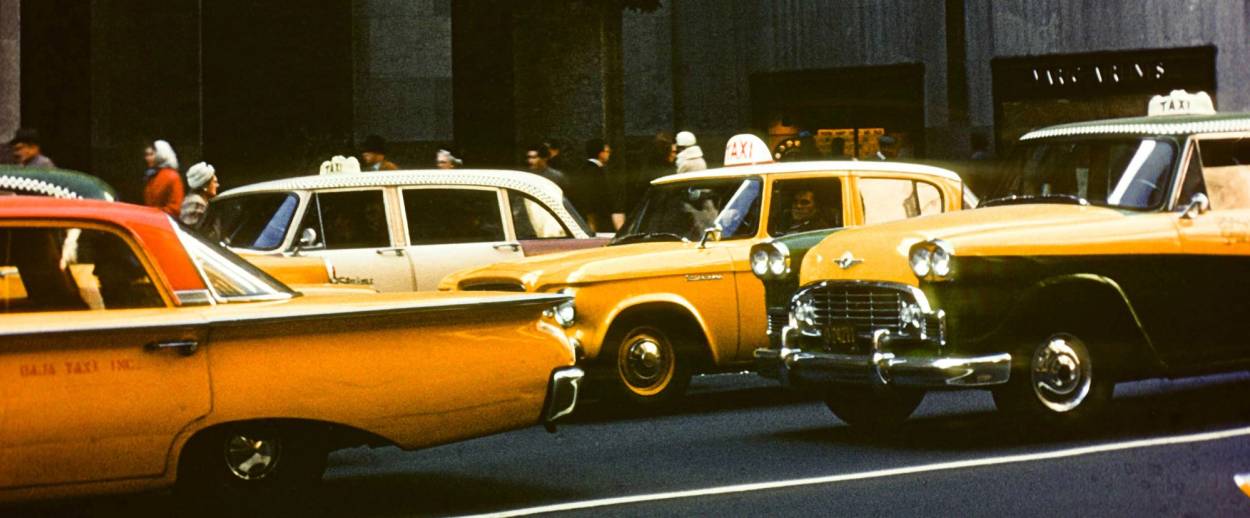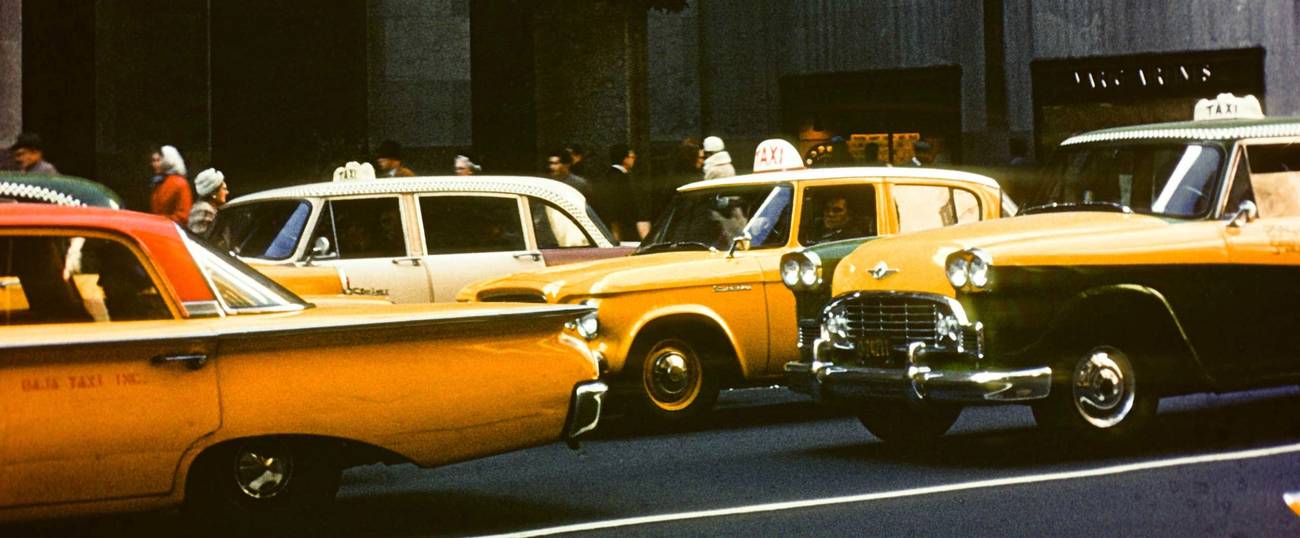In the Driver’s Seat
Remembering the bygone era when the quintessential New York cabbie was Jewish




A sunny yellow cab darts and weaves amid an armada of glum, black utility vehicles, catching my eye. As I stand on a street in the very heart of Manhattan, I can see it coming a mile away, which is the point, after all. Its bright, snappy exterior makes the vehicle pop. The use of yellow as a distinguishing mark is a fairly recent phenomenon, mandated by New York’s municipal authorities only in 1967; previously, cabs came in many hues, red and lavender among them. Although there’s something to be said about an abundance of color on Gotham’s thoroughfares, the sprightly yellow seems just right, in sync with the city, the visual equivalent of its vibrant, untrammeled spirit. And more. Thanks to the presence of this brightly colored car-for-hire, yellow—an Old World symbol of confinement ever since the Middle Ages—acquired a new, more beneficent meaning in the New: an expression of mobility, of getting from here to there.
The next time you’re up and about on the city’s streets, take a good look at a taxi as it speeds by, for its days are numbered, or so The New York Times recently observed.
The once-ubiquitous vehicle has increasingly ceded pride of place to Uber and Lyft. Accustomed to flailing their arms to summon a cab, New Yorkers now prefer to use their thumbs in lieu of their limbs: tap, tap, tap. “It won’t be long before this is an Uber town, instead of a yellow-cab town,” predicts one New Yorker. Confirms another, “I don’t remember the last time I took a yellow cab. My son had a bar mitzvah every single weekend for six months. I never took a cab. I either took Via or Uber to take him there and to pick him up.”
Those of us who place a premium on convenience and ease are not apt to mourn the yellow cab’s diminished role in our lives. The same holds true for those who go with the flow and comfortably accommodate change, be it vehicular or political. But for the rest of us, especially those with a keen sense of history, the yellow cab’s impending exit brings to a close a moment in time when its fortunes were closely aligned with those of New York’s Jewish residents.
For many years, beginning during the interwar era and continuing well into the 1970s, a strikingly hefty proportion of those in the industry were Jewish, reportedly accounting in 1920 for as many as 20,000 out of 35,000 drivers in the Big Apple. Their prominence was as much perceptual as statistical. In the public imagination, the quintessential cabbie was a wise-cracking, seen-it-all, Yiddish-speaking (or -inflected) New York Jewish male. It’s not for nothing that the celebrated 1932 Warner Bros. film Taxi! featured its protagonist, James Cagney, a fiercely independent cab driver at odds with evil men who would control the industry, in an extended conversation, auf yiddish, with one of his passengers.
Then again, you need only summon up thoughts of Taxi, the long-running ABC sitcom, to realize the extent to which ethnicity, particularly Jewishness, suffuses the cab business. The television show starred Judd Hirsch as Alex Reiger, a world-weary cabbie who doubles as the moral center of the Sunshine Cab Company; Danny DeVito as its irascible dispatcher, Louie De Palma; and, most memorably, Andy Kaufman as Latka Gravas, whose indeterminate accent and equally fuzzy origins furnished some of the program’s most hilarious moments.
The show’s writers didn’t have to go too far afield for their material. The economic realities of urban New York supplied them with more than enough incident, personality, and plot to keep the wheels of the show, as well as its laugh track, in perpetual motion. A niche industry, an integral part of the immigrant economy, driving a cab didn’t require any capital to get started, which is why immigrants, then as now, found it attractive. All you needed was the ability to drive a car.
You didn’t need much social capital, either. It certainly helped if you knew your way about town, could follow directions, and converse amicably with your passengers, but none of those skills was a prerequisite, much less a bar, to driving a taxi. That you could also set your own hours enhanced its appeal among those who observed Shabbat and the holidays, freeing them from the tyranny of the timetable. Though they put in a very long day, taxi drivers were not nearly as bound to the clock as their cousins who worked at a desk or in a factory.
Way back when, you could also make a decent living as a taxi driver, earning (and saving) enough to send your kids to college and perhaps even to purchase a medallion of your own. A one-generation phenomenon, driving a cab was more of a way station than a permanent condition, which heightened its appeal among immigrant Jews. They weren’t stuck behind the wheel forever; upward mobility and with it, the promise of America, was within reach.
***
Like this article? Sign up for our Daily Digest to get Tablet Magazine’s new content in your inbox each morning.
Jenna Weissman Joselit, the Charles E. Smith Professor of Judaic Studies & Professor of History at the George Washington University, is currently at work on a biography of Mordecai M. Kaplan.